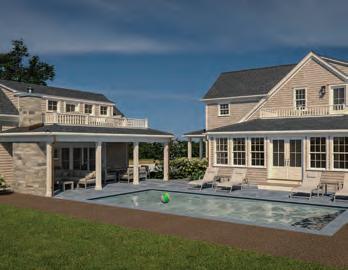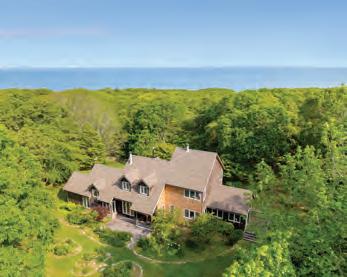VINE THE



Singing the blues, playing the rock: the band, the Bluefish
Two friends, 20 years & one lighthouse
Big flavor and big community at Black Joy Kitchen
Books for the beach, dogs at the beach

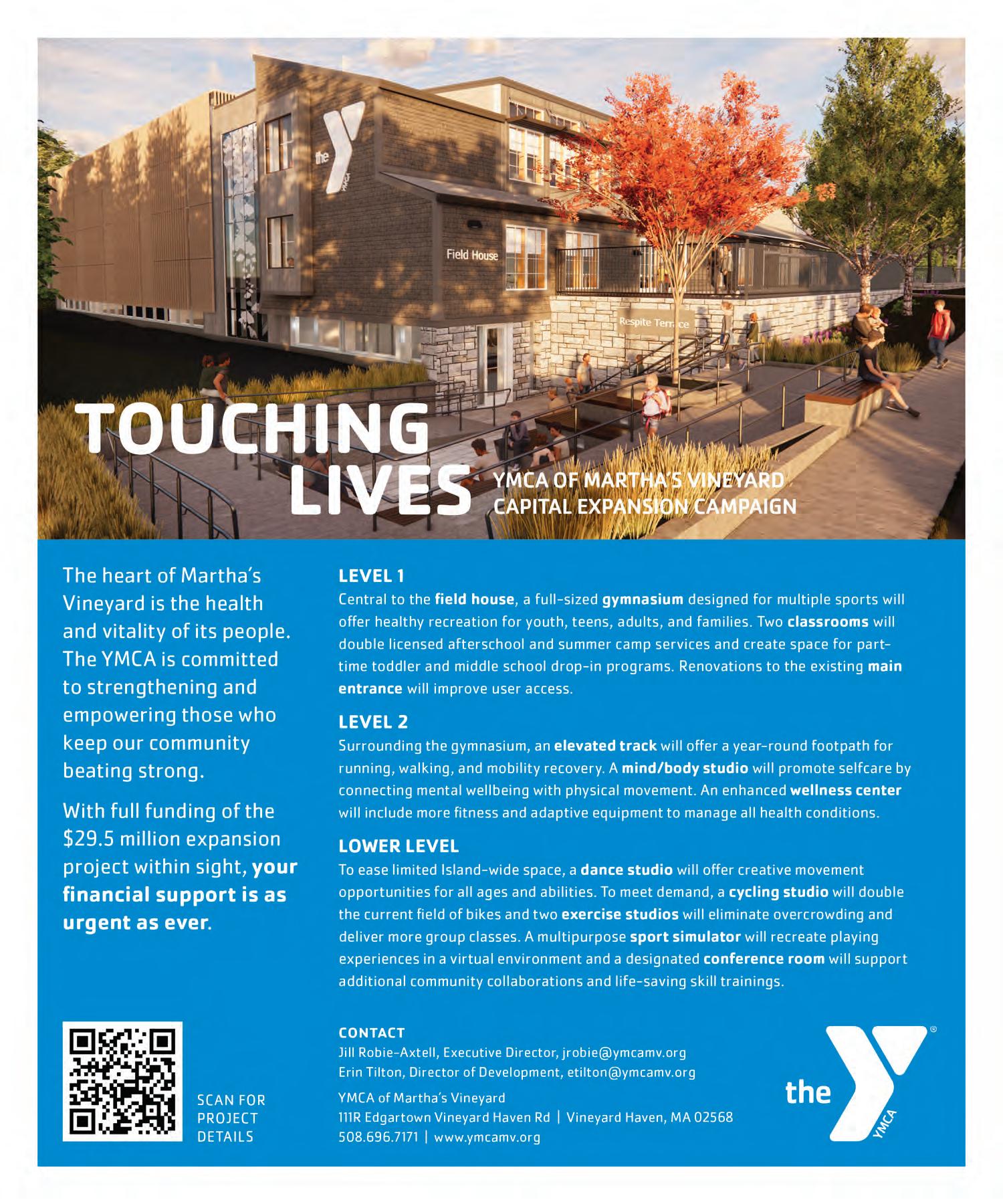
14 SINGING THE BLUES, PLAYING THE ROCK
Johnny Hoy and the Bluefish keep a good thing going on an Island where musical talent runs deep.
By John H. Kennedy
18 THE KEEPERS
Longtime friends and Oak Bluffs neighbors Rob Hammett and Steve Durkee have been keeping the doors of the East Chop Light open for 20 years.
By Susie Middleton
From the Editor
Reading Sissy Biggers’s interview with Rev. Dr. Otis Moss III (page 10), I was struck by his suggestion that we use this time — right now, this August, here on the Vineyard with friends, family and endless fun activities — to recharge. To rest and enjoy these moments, but at the same time to begin gathering our energy for going forward on a path of good works.
I like the idea of unplugging – taking a book to the beach (page 6), taking a dog to the beach (page 24), climbing a lighthouse (page 18), having supper with friends at Black Joy Kitchen (page 8) and most definitely going to hear live music as much as possible (page 14), preferably in a beach chair with a picnic. But you might prefer to go dancing at The Ritz. Or like the owl and the pussycat, you could “dance by the light of the moon, hand in hand on the edge of the sand.”
But I’m looking for inspiration too. I’m hoping to get a chance to hear Pastor Moss preach at Union Chapel on August 3. He’s also a film producer and a visual storyteller, and I think seeing him in person might help me wrap my head (and heart) around ways to merge faith, justice and compassion. I’d like to fall into that slipstream.
In the meantime, I’ll turn my face to the sun and soak up all the rays I can.
– Susie Middleton
Big Flavor, Big Community: Black Joy Kitchen 10 Q&A
An Interview with Rev. Dr. Otis Moss III 24
26
EDITOR
Susie Middleton
ART DIRECTOR
Jared Maciel
CONTRIBUTORS
Sissy Biggers, Chris Burrell, Molly Coogan, Mindy Dutka, Ray Ewing, Laura Holmes
Haddad, John H. Kennedy, Jeanna Shepard
PUBLISHER
Monica Brady-Myerov
GENERAL MANAGER
Sarah Gifford
ADVERTISING DIRECTOR
Frederica Carpenter ads@vineyardgazette.com
AD SALES TEAM
Carrie Blair, Isabela Fernandez, Serena Ward
MARKETING & SPONSORSHIPS
Tresa Lovio-Slattery
EVENTS MANAGER
Kharma Finley-Wallace
AD PRODUCTION
Jane McTeigue, McKinley Sanders
Copyright 2025 by the Vineyard Gazette Media Group. No part of this publication may be reproduced without the written permission of the publisher.
To subscribe to the Vineyard Gazette, visit vineyardgazettestore.com Vineyard Gazette Media Group
P.O. Box 66, 34 So. Summer Street, Edgartown, MA 02539 thevine@vineyardgazette.com | 508-627-4311




Blinds, Shutters, Roman Shades, Curtains 15 Merchants Court, Vineyard Haven





BY MOLLY COOGAN
Time was, my beach bag, if I even bothered to pack one at all, contained a ratty towel, a pack of Camel Lights and a book. Health, hydration and sun protection were of little concern, and my musculoskeletal demands did not yet require me to schlep a chair to the beach. Not that my ego would have allowed it anyway.
Nowadays, my standard beach setup looks like a yard sale, replete with a selection of paperbacks, since I’m never sure what my reading mood will be once I’m there. So for anyone looking forward to catching up on their reading this August, I have some recommendations of great books you may have missed in hardcover last year that are now available in paperback.
1. The Wide Wide Sea: Imperial Ambition, First Contact and the Fateful Final Voyage of Captain James Cook by historian Hampton Sides (Vintage, $19), a New York Times top 10 book of 2024, has proven to be just as popular in paperback as it was in hardcover, so what are you waiting for?
A couple of Pulitzer Prize–winning non-fiction titles are also now available in paperback. 2. No Right to an Honest Living: The Struggles of Boston’s Black Workers in the Civil War Era by Jacqueline Jones (Basic Books, $22.99) is an immersive account that challenges and lends nuance to the myth and history of the north as a beacon of freedom and opportunity.
3. King: A Life by Jonathan Eig (Picador, $23) is a landmark biography of Martin Luther King, Jr., the first to



include recently declassified FBI files and the most important portrait of his life in a generation. If fiction’s more your thing, you may have a hard time choosing. But why limit yourself to only one book, anyway? 4. Sandwich by Catherine Newman (Harper Perennial, $18.99) was one of last summer’s bestsellers in hardcover and is flying off the shelves in the new paperback edition. Set on Cape Cod, it’s a moving, hilarious story of a family summer vacation full of secrets, lunch and learning to let go.


If you enjoy literary thrillers, then you’ll want to pick up 5. All the Colors of the Dark by Chris Whitaker (Crown Publishing Group, $19): “a missing person mystery, a serial killer thriller, a love story, [with] a unique twist on each.” And finally, don’t miss the opportunity to see author Essie Chambers at the Katharine Cornell Theater on July 29. Her bestselling debut novel, 6. Swift River (Simon & Schuster, $17.99), about a complicated bond between mothers and daughters, the disappearance of a father and the long-hidden history


of a declining New England mill town landed on many year-end lists and was an NAACP Image Award nominee and a Read with Jenna pick.
We’re just brimming with recommendations at the bookstore, so stop in and ask us about what we’re reading this summer. You can even pick up a beach bag, a sun hat and some stickers for your water bottle while you’re here!
Molly Coogan is co-owner of Bunch of Grapes Bookstore in Vineyard Haven.
Scan for our full calendar of events.



in





Jarrett Hurwitz | Keller Williams Realty | 845-596-6740

12 Boldwater Road, Edgartown
Immerse yourself in timeless elegance and meticulous craftsmanship in this 8-bedroom | 12-bathroom estate. From the grand foyer to the dramatic living room, each detail exudes sophistication. Step outside and discover a remarkable pool and pool house with a fullyequipped gym. Offered at $9,995,000.
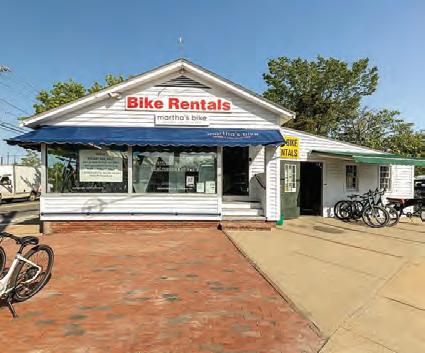
4 Lagoon Pond Road, Vineyard Haven
Located at the five corners, this rare commercial property presents an opportunity to set your future business venture up for success. This prime location captures the attention of every single vehicle disembarking the Vineyard Haven Ferry! There are 2.5 parking spots included. Offered for $1,445,000.

8 Fresh Pond Rd, Oak Bluffs
Designed for luxurious living and / or rental potential, this expansive property offers a new pool, lush landscaping, and Fresh Pond access. Featuring three full kitchens, it functions as a spacious single-family home or three separate units—ideal for multi-generational living, guests, or income. Exclusively offered at $5,295,000.
Contact Jarrett Hurwitz at 845-596-6740 for more information.
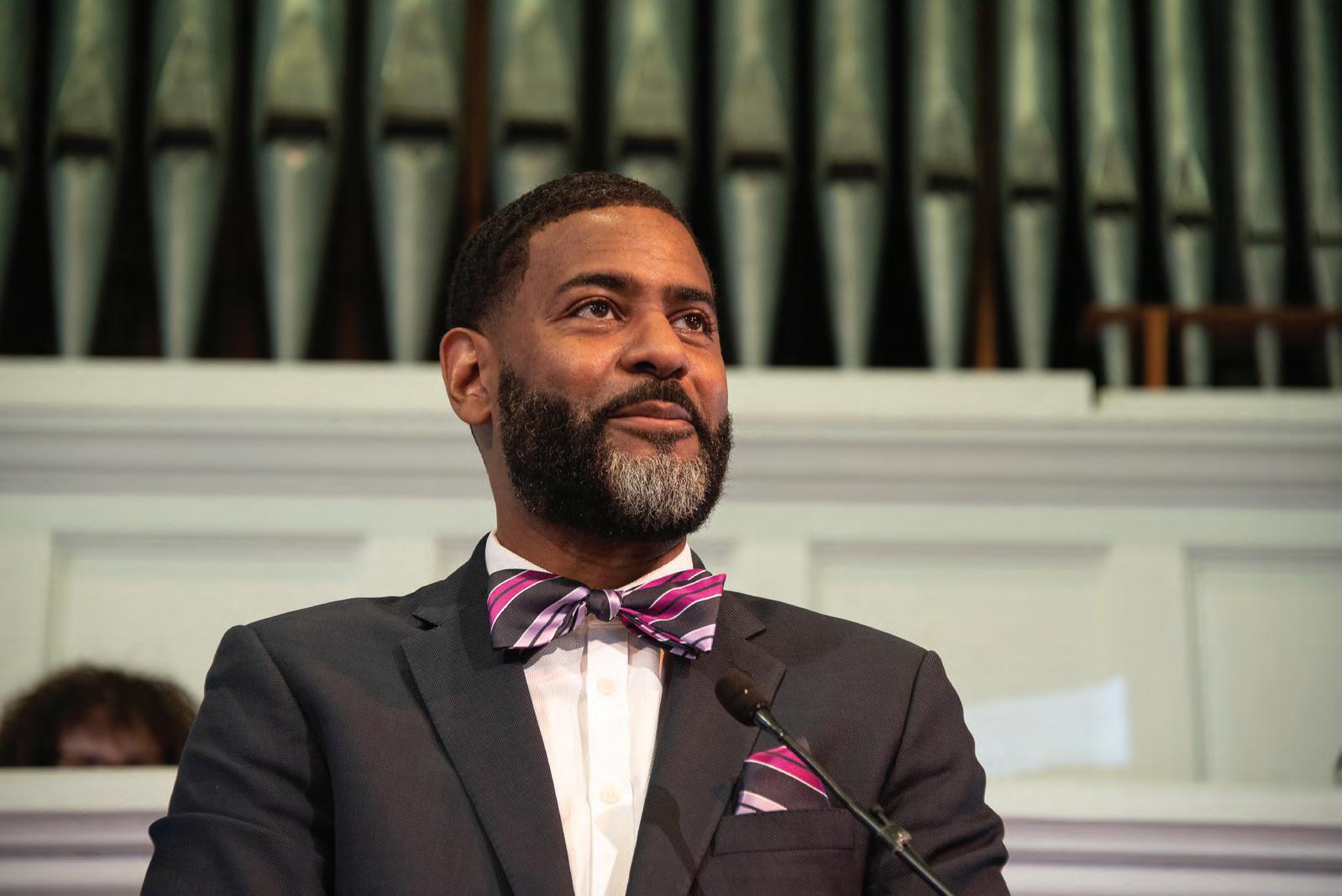
BY SISSY BIGGERS • PHOTOS BY JEANNA SHEPARD
In his much-anticipated annual visit to Martha’s Vineyard, Rev. Dr. Otis Moss III will preach at Union Chapel in Oak Bluffs on Sunday, August 3 at 10 a.m. With his voice booming from the historic octagonal walls to a congregation that spills out into the park surrounding it — creating an outdoor sanctuary and an unmistakable Oak Bluffs happening — Otis’s sermon has become a cherished tradition for many summer visitors.
A third-generation minister and senior pastor of Chicago’s Trinity United Church of Christ, Otis is known for blending theology with justice, storytelling and the arts. A passionate cinephile and filmmaker, he’s the
founder of Unashamed Media Group and the creator of sermonic films — visual expressions of the Gospel designed to reach new audiences. A lover of jazz, hip-hop and Black cultural history, he brings all of these influences to bear in the messages he shares — many of them shaped by more than a decade of preaching, connecting and recharging on the Vineyard.
I caught up with Otis over Zoom in July, just ahead of his visit. We talked about family, film, the Island, and the intersection of faith, service and resistance. His message is clear: faith should speak to every part of our lives — not only the personal, but the public
and political as well.
Q: You come from a long line of faith and activism; both of your parents were leaders in the Southern Christian Leadership Conference — and your father was pastor for churches in Georgia and Ohio until his retirement in 2008. When did you personally feel the call to ministry?
A. It happened during my sophomore year at Morehouse College. I was recruited to play football and switched to track, and at the time, I was trying to discern between cinematography, political science, religion and philosophy.
One day as we were winding down practice, jogging in circles like we always did, I heard a voice — clear as day — ask, “When are you going to stop running in circles?” That moment stopped me. I went back to my dorm, called my girlfriend — who’s now my wife — and told her. She just said, “I
knew.” And it turns out, so did a lot of the people closest to me.
Q: Those interests you had as a young person considering film, philosophy and politics seem to have found their way into your ministry, which extends beyond the pulpit to filmmaking.
A. I’ve always been deeply connected to the arts — to storytelling, writing and especially film. I’ve kept journals for years, written plays and sermons, and now I’m producing documentary and narrative films through our production company, Unashamed Media Group. It began in earnest during the pandemic. With churches shut down, I wanted to create something more than a static Zoom box. So I leaned into my background — studying cinematography at Morehouse — and started writing sermons as scripts, then building visual experiences around them. We called them “sermonic films” and those early pieces went
viral. Then came Otis’ Dream, a short film about my grandfather’s struggle to vote during Jim Crow. It’s now used in schools and churches across the country, from Louisiana to North Carolina, to teach civics in 12 minutes. We recently received a grant from the Lilly Endowment to produce seven new films over the next five years. These projects will continue to explore the intersection of faith, culture and justice.
Q: Do you see filmmaking and preaching as separate, or are they different expressions of the same calling?
A. The Gospel is the priority, but it goes hand in hand with stories we’re creating, which are rooted in faith, culture and social justice. It’s an extension of what we do every Sunday. It’s been a real privilege to write and curate the kinds of stories and experiences that will allow people to see the world in a different way.
Q: Let’s talk about Union Chapel in Oak Bluffs. What do you feel when you step into that pulpit each August?
A. There’s a sacredness — a sublime energy to Union Chapel. The unique creation of people coming together for the summer represents what the American project is supposed to be. People coming from all these different places and spaces ethnically and racially. It’s a beautiful thing. It’s gumbo in motion.
And it’s deeply intergenerational — you see grandparents and young children worshipping together. It’s not just biological families. People become family over these gatherings and have formed chosen families through this shared tradition. It’s beautiful.
Q: Do you remember your first time preaching at Union Chapel?
A. It was sometime around 2010. My son was about 10 or 11. I came the first year alone and knew right away that next time, the whole family would need to come. We’ve made it a tradition ever since.
Q: You preached alongside your father at Union Chapel in 2015. Can you share what that meant to you?
A. That was incredibly meaningful. In Chicago, my father and I started a tag-team sermon every Father’s Day. The joy of the experience is, of course,
standing with my father. But the real joy is in the process of preparing the sermon — listening to his wisdom and stories and working through ideas — like a jazz session. It’s something I hold near and dear to my heart.
You know, [John] Coltrane said some of the best music happened in practice, not performance. It was the same with us — working out themes, tossing ideas back and forth. That’s what I treasure most.
Q: How did you find your own voice, especially growing up with the large presence of your father?
A. Like any artist, you start with imitation, then move to emulation — and eventually arrive at authenticity. I started out mimicking my father, Gardner Taylor, Carolyn Knight and others I admired.
Then I became a youth minister, trying to reach young people, and that forced me to find a new rhythm. I drew from hip-hop, poetry, film — anything that communicated with power and clarity. All of that shaped how I preach now.

Q: Will you do that at Union Chapel?
Q: Have you personally been involved in any of the national protests or recent expressions of resistance?
A. Yes, consistently. Resistance for us is part of the ministry. Over the past year and a half at Trinity, we began doing something we call “Five Minutes After the Benediction.” I’ll say, “Just give me five minutes,” and in that time, I’ll break something down — explain a policy, highlight an injustice or call attention to who’s really pulling the strings.
One week I talked about Project 2025. Another time, I called out what’s been branded “The Big Beautiful Bill.” I called it “The Big Betrayal of Human Decency.” That bill would strip 12 million people of healthcare and cut off support for young adults aging out of foster care.
I want our congregation to understand that policy reflects our moral compass. Budgets show what we value. If we’re people of faith, we must be engaged in the public square — not just personal piety.
We’ve also organized through the Black Church PAC [Political Action Committee] — bringing together ministers across the country to focus on policy, to support candidates and to mobilize for justice. We’re not just preaching resistance — we’re living it, every week.
A. Probably not in that format. But those themes — justice, compassion, the public good — are always embedded in the message.
Q: Over these nearly 15 years visiting the Island, have you built lasting connections?
A. Definitely. I look forward to seeing one family in particular — a young brother and sister. Every year I give them a lapel pin of an historical figure. I tell them, “Ask your parents about this person.” It’s a little tradition now. One of the kids I watched grow up became an intern at our church in Chicago. That kind of relationship — born on the Vineyard — is special.
Q: What’s on your summer reading list?
A. I just finished James by Percival Everett — phenomenal book. I’ve got another of Percival’s ready to go, Dr. No. I’m also reading S.A. Cosby — noir thrillers in the vein of Walter Mosley or Dashiell Hammett. I love a good noir — whether on the page or the screen.
Q: Will your family be joining you on the Island this year?
A. Absolutely. My son Elijah, who’s 24, has a student film premiering at the Martha’s Vineyard African-American Film Festival — Sadness of Men. He’s studying film at Loyola Marymount
University in Los Angeles and he’ll be on the emerging filmmakers panel. My daughter Makayla is 21 and Monica, my wife, is perpetually 22.
Q: What’s the perfect Vineyard day for your family?
A. It has to be — without a doubt — breakfast cooked by my wife and mother-in-law. There’s a crew of young people who come not just for the pancakes, the eggs, the omelets; it’s so they can be in the presence of Monica and Mama Brown when they are hooking up breakfast. It’s a wonderful thing to witness.
Q: What would you say to someone who picks up this issue of The Vine but missed the opportunity to see you at Union Chapel? What message might they carry with them?
A. The Vineyard is a place of rest, yes — but also of recharging. The question is, what will you do with the recharge? Will you use that restored energy to sow good in your community? That’s all any of us can do — plant seeds of justice, compassion and love where we are.
Sissy Biggers is the Q&A columnist for The Vine and a regular contributor to Martha’s Vineyard Magazine. She lives in Oak Bluffs.

BY LAURA HOLMES HADDAD • PHOTOS BY RAY EWING
Every dish tells a story, and executive chef and founder Chef Ting is sharing volumes in her new restaurant, Black Joy Kitchen. Drawing on her global culinary background and flavors and dishes from the Black diaspora, Chef Ting and her team are bringing their vibrant, flavor-infused perspective to Oak Bluffs. From Maalay Qumbe (coconut fish curry from Somalia) to Huacatay Shrimp & Pineapple (from Peru) to Doro Wat with Inerja (spicy chicken stew from Ethiopia), these are dishes you will not find anywhere else on the Island — or in this combination practically anywhere. It’s a heady and fragrant journey that truly feels like a trip around the world on your palate.
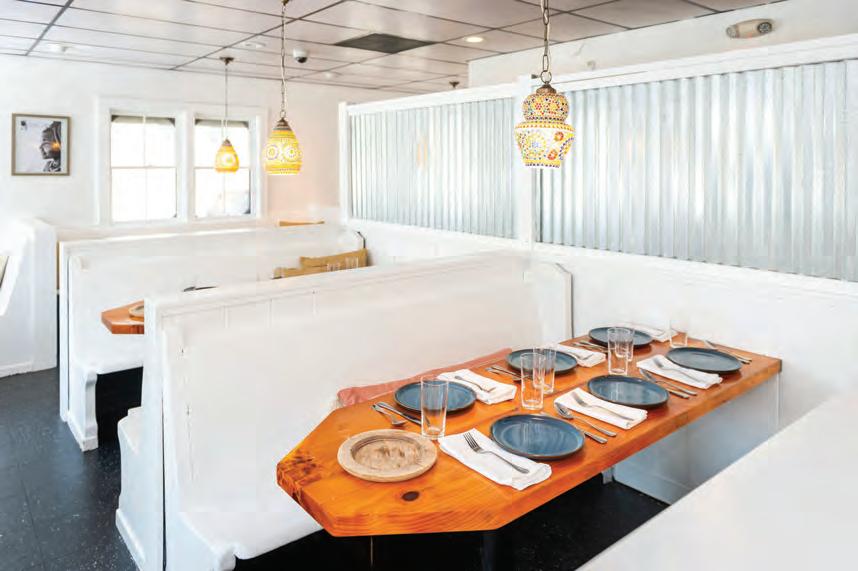

The extensive menu reads like a travel guide, with ingredients and the geographic roots of each dish offering layers of insight. There are dairy-free, vegan, vegetarian and gluten-free options so everyone can enjoy the sharable, family-style dishes. A related series of dishes called journeys offers diners a way to taste several items at once. The rice journey includes four types of rice dishes: Gullah red rice (South Carolina), rice and peas (Trinidad & Tobago), Jollof rice (Ghana) and Moros Y Christianos (Cuba). The greens journey travels from Cameroon to Mississippi, from casava leaves to collard greens. Hearty dishes such as BBQ meatballs
and billionaire’s bacon bouquet (both from Georgia) bring tangy-sweet flavors while the crispy whole piri-piri snapper (Cape Verde) is as light as air. For dessert, the passionfruit situation (Tanzania) and a big slice of Kentucky butter cake are the perfect sweet and buttery notes to follow the spicy umami of the main dishes.
Chef Ting is excited about the restaurant’s Sundays-only brunch BBQ menu. “It allows us to lean in to some African American classics,” she says. “On Saturdays and Sundays most people roll off the ferry and the [rental] house isn’t ready yet. I want them to be able to head over to Black Joy for a family barbeque.”
A commitment to community extends to the ingredients on the menu. The restaurant sources produce from Morning Glory Farm and Beetlebung Farm. The seafood is sourced from Aquinnah, including scallops, bluefish and striped bass.
And Chef Ting relies on Island resident Ms. Paulette to make jars of pickliz, a Haitian pickled condiment dish used to top the Sos Pwa, a Haitian rice dish.
Family is what first brought Chef Ting to the Island, starting in the early 1970s, when she would travel from Brookline with her family. “My white mom and Black dad got married in the 1960s and the Vineyard became a haven for them,” she says. “It was where we would see a lot of families like ours.”
So it’s no surprise that family is an intrinsic part of Black Joy Kitchen. Chef Ting’s wife, Melissa Bradley runs the business side of the restaurant and two of their daughters and a niece work on the restaurant floor. And despite living thousands of miles away in Hawaii, Chef Ting’s oldest daughter Gabriella — also a chef — created three recipes for the restaurant menu.
The sense of family is evident from the moment you walk in the door.



A wooden spice cabinet (an antique library card catalog) against the wall holds more than fifty spices in pullout drawers. Called Gabriella’s Spice Curiosity Cabinet, it’s a tribute to Gabriella’s curious nature that started at age three when she opened each drawer and memorized various spices. Chef Ting enjoys mentoring and empowering young chefs, and it takes a solid team to steer a new restaurant while she also oversees a bustling catering business and moves forward with a cookbook. Sous Chef Chris Quiles is taking the lead in the kitchen, with help from Chef Malika, who drives the production, and a team of four more cooks.
A curated wine list includes wines from House of Brown — part of Brown Estates, a Black-owned family winery in Napa Valley. But Black Joy Kitchen also has an exciting cocktail menu to tempt you. There are plenty of classics and old favorites, but fresh takes that

incorporate flavors of pineapple, passionfruit and strawberry are dazzling. The mocktails are packed with flavor and are a refreshing addition to a meal. Don’t miss the Be Easy on the Beat, a blend of hibiscus strawberry shrub, fresh mint, lime and club soda.
Sitting at a table on a Saturday night in the bright, airy space, the sounds speak volumes. With laughter, the clicking of cocktail shakers, diners chatting with each other in the aisles, it’s clear that this is a place that nurtures community. Celebrating flavors of the Black diaspora while creating a welcoming space comes naturally to Chef Ting and her team, and it shows in every single detail. Black Joy Kitchen is certain to become a year-round gathering spot.
Laura Holmes Haddad is a former cookbook editor and regular contributor to The Vine
OPPOSITE: With Black Joy Kitchen, Chef Ting has brought a welcoming and fresh vibe to the Oak Bluffs space that formerly housed Bombay Indian Cuisine. The bar is a great spot to sit and sip a mocktail or cocktail like "50 Percent Pleasure, Five Percent Pain." ABOVE: Dishes inspired by the Black diaspora. Clockwise from top left: Maalay Qumbe (coconut fish curry, Somalia); Bedazzled Avocado Dream (Puerto Rico); Misir Way with Inerja (Ethiopia); Huacatay Shrimp & Pineapple (Peru).
7 Oakland Avenue, Oak Bluffs (508) 338-7550
Open Wednesday – Saturday, 5 to 11 p.m.; Sunday 11 a.m. to 4 p.m. Reservations accepted and encouraged blackjoykitchen.com @blackjoykitchen









Johnny Hoy and the Bluefish keep a good thing going on an Island where musical talent runs deep.
BY JOHN H. KENNEDY • PHOTOS BY JEANNA SHEPARD
After more than thirty years and thousands of gigs, the frontman and the keyboard player are still together, bringing their own blues band vibe to Vineyard stages.
Sure, there’s a lot of gray and white hair on the dance floor when Johnny Hoy and the Bluefish performs. But Johnny, on vocals and harmonica, and Jeremy Berlin, on keyboards, are still in high demand, delivering to enthusiastic audiences around the Island and beyond. And they have a budding star on guitar, Delanie Pickering, who’s attracting notice beyond the Vineyard’s humble shores.
The band’s longevity comes against the backdrop of a vibrant music scene on the Island, particularly during summer months when musicians are amping up at traditional venues such as The Ritz and the Portuguese American Club, and a host of other spots looking to employ siren song(s) of live music to lure customers and patrons.
“I think people are realizing that competition is fierce and if they want to get people in there, they have to try to make a vibe that’s happening,” Johnny says. “Live music seems to be a tried-and-true recipe for bringin’ in a few extra people.”
Just a few examples include the restaurant Nomans in Harthaven, which features live music virtually every night. The Port Hunter in Edgartown has live music most nights. Featherstone Center for the Arts features the Bluefish every Friday, in addition to a live music series on Mondays. The Tabernacle runs out live music each Friday evening; the Vineyard Preservation Trust and guitarist/vocalist Mike Benjamin are producing a new Wednesday evening series at the Grange Hall. The Black Dog Tavern and Black Dog Café separately sponsor live music every
week. A new entry, MV Tap at Five Corners, has blues in the late afternoon and guest musicians on a rotating basis. Edgartown and West Tisbury libraries frequently feature live music, and Martha’s Vineyard Museum has a Wednesday concert series spotlighting music across genres. (See page 17 for a complete list of live music venues.)
“I think the music scene here is remarkably full, in some respects,” says Jeremy. “The Island keeps growing musicians, and I think it’s because it’s an island and because people are exposed to each other in kind of an insular environment. We
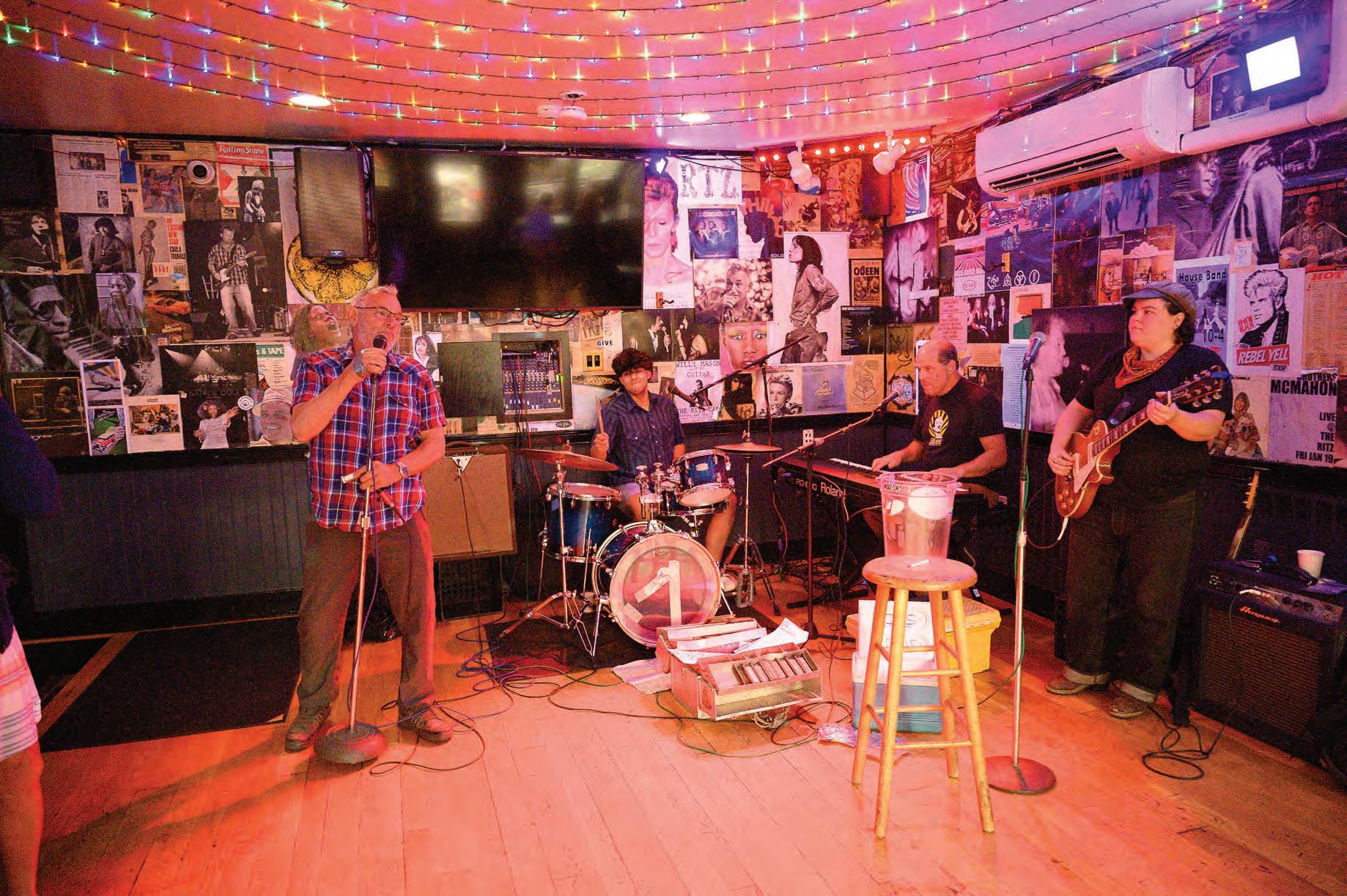
see each other all the time.”
Larkin Stallings, who owns The Ritz in Oak Bluffs with his wife Jacqueline, says the Vineyard punches way above its weight when it comes to talent. He should know; he and his wife also are operating partners in two – soon to be three – dance hall saloons in Houston. Without skipping a beat, he mentions Martha’s Vineyard in the same breath as Nashville and Austin.
“ The one thing that is special about this Island is we have an incredible resource of artists,” says Larkin. “You just go down the list, it’s pretty spectacular. It’s certainly unusual. Even some big cities don’t have this talent pool.” He ticks off a long list of names, which includes everyone from musician/preacher Sean McMahon and Island homeboy Phil daRosa
to singers Darby Patterson, Joanne Cassidy and Jodie Treloar Sampson.
And then there’s the estimable Mike Benjamin, who might be the Island’s longest tenured musician. His band plays regularly at the Ritz and Nomans.
When they started in 1989, the Bluefish included Johnny’s then-wife Barbara Puciul on bass, guitarists Slim Bob Berosh and Don Groover, and drummer Nicky Huff. As one might expect, there’s been a fair amount of turnover over the years, but some band alums return for short stints. Taurus Biskis, of the musical Biskis family, was the drummer for the band in the ’90s. He’s involved with his own family’s band now but plays with the Bluefish during the winter months. Slim Bob sat in as the band’s guitarist in April, when
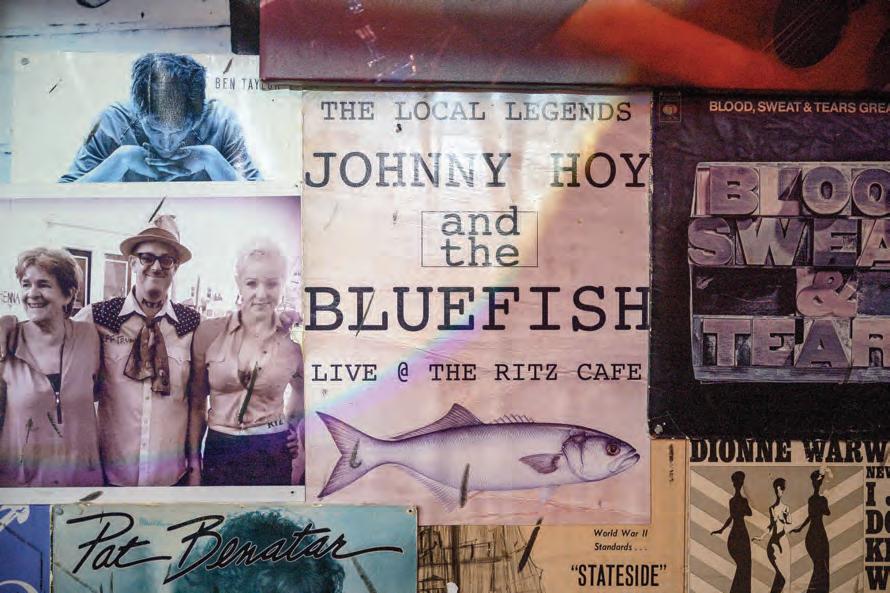
Delanie was in Europe.
The two constants have been Johnny and Jeremy. Johnny, 68, arrived on the Island in the ’80s after a vagabond childhood, constantly moving with his family because of his father’s jobs. Even at age 17, he had the wanderlust. He became adept at riding the rails, crisscrossing the country. (He even joined the circus for a week or so, helping drive the trucks that hauled the lions and tigers.) Right around then he focused on the harmonica, dazzled by the work of legendary harmonica player James Cotton and other blues artists.
Jeremy, 63, was a summer kid from Cambridge who ended up opening at the gone-but-not-forgotten nightspot Hot Tin Roof for a long list of jazz luminaries that included Ahmad Jamal, Dave Brubeck, Dizzy Gillespie and Les McCann, and played in a Nina Simone tribute band. He still has his own solo gig most weeks at Sweet Life in Oak Bluffs and periodically plays in a jazz trio with Taurus and bassist Eric Johnson.
In addition to keyboards, he’s
the band’s unofficial manager who coordinates their schedule, which may include mainland gigs ranging from a dive bar in Providence, Rhode Island, to a swanky jazz club in Portsmouth, New Hampshire.
And then there’s Delanie, 28, from Concord, New Hampshire, who was living in her van when she arrived on the Island about seven or eight years ago. She proceeded to go to every Bluefish gig she could, and soon she was asked to sit in and eventually become a full-fledged member.
“I’ve been really lucky to have a lot of great guitar players, but none of them were cute girls that could sing beautifully,” says Johnny. “And there’s a charisma there. It’s hard to put your finger on what it is, but she’s got it... and the world is starting to notice.”
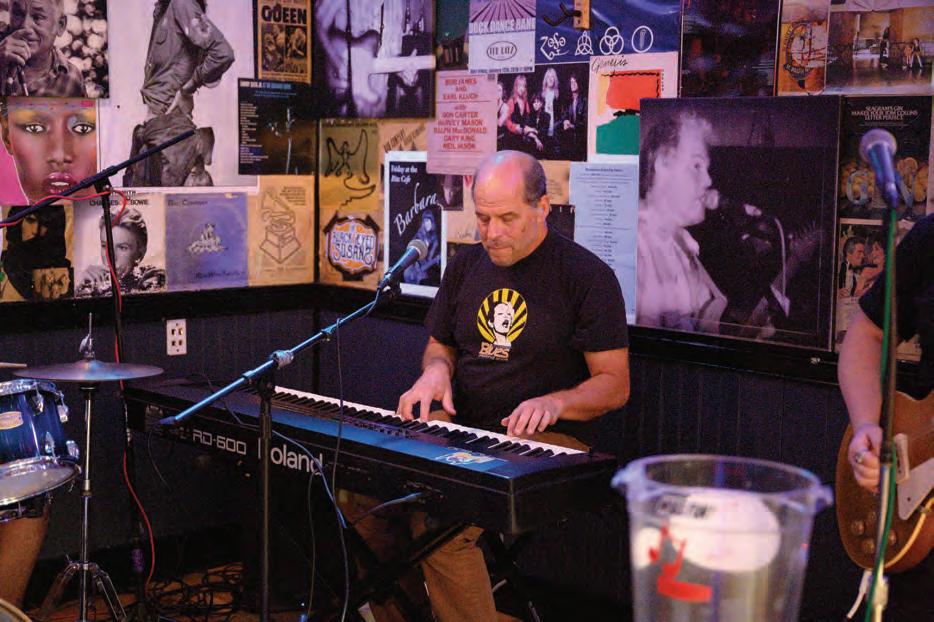
Delanie played in Europe last November and then again for the entire month of April. She’s headed back for short stints this summer. But make no mistake: she’s content as a member of the Bluefish, living on the Island. Besides, she’s bought a house. “So, I’m living inside,” she says, smiling.

Filling out the band’s lineup in the summer and for off-Island winter gigs is promising young drummer Cam Igo, a Berklee College of Music student. Most musicians on the Island have day jobs, especially in the winter, when the music scene is much leaner. Or they go south in the off-season. Johnny is a stonemason, a fisherman and a farmer — and by virtue of his many talents, the recipient of the Creative Living Award in 2016. Delanie works in construction and at a coffee shop. Jeremy relies on playing music whenever and wherever he can — birthday parties, memorial services and library concerts. He also uses his organizational skills to help feed a steady flow of musicians to a cruise ship that anchors in Vineyard
orward? Johnny says that he’s spending more time on his music than ever before. “For the first time in my life now, I can think about music
and do a little practicing during the day,” he says. “All my musical life, music was the red-headed stepchild. It wasn’t the thing that came first, second or third in my list of priorities. It was all the way at the bottom. Now, it’s up there. And I’m happy about that. Now I feel like I kind of am keeping up with my band.”
While the hustle and grind can be grueling, people keep asking: Can you play on this date? One recent afternoon, Jeremy’s phone vibrated with a text, inquiring about that Sunday night. Sorry, already booked.
“We’ve got this thing going,” Jeremy says. “People keep calling. So a gig is booked and by dint of the fact that you have a gig booked you have to keep going.”
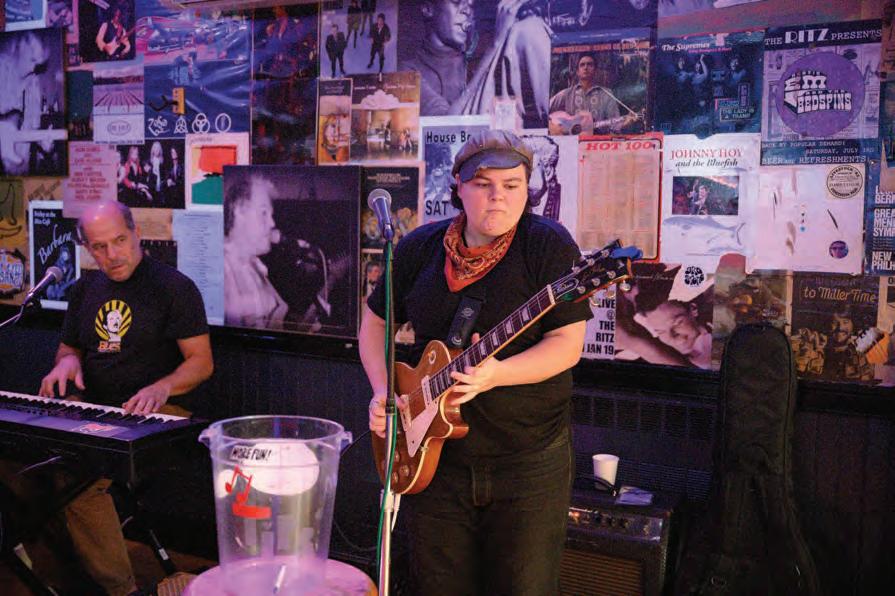
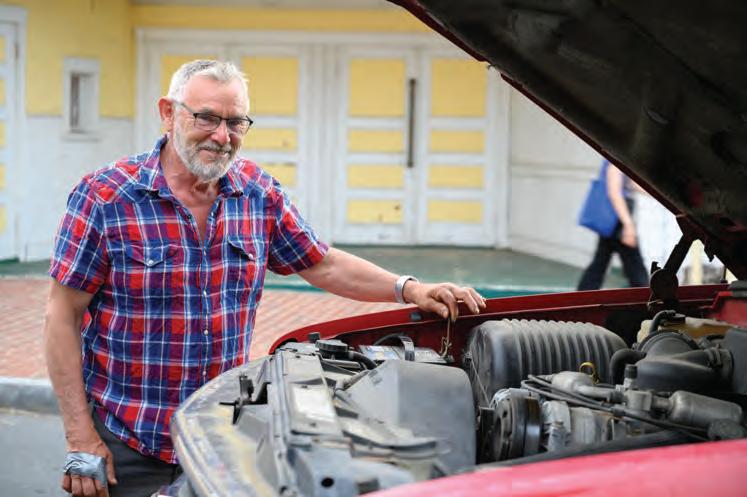
JOHNNY HOY
Frontman, harmonica player and vocalist, Johnny started the band in 1989. A household name on the Island, Johnny received the Creative Living Award in 2016.
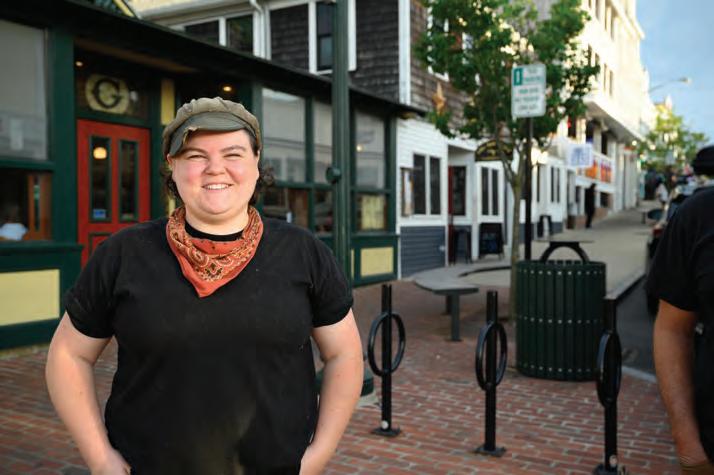

While there are special event venues such as the Old Whaling Church and the Martha’s Vineyard Performing Arts Center that host musical acts over the summer, the following list is of places that regularly and repeatedly feature live music. Visit their websites, Instagram pages or calendar. vineyardgazette.com for more information about specific schedules.
AQUINNAH
Cliffhangers
CHILMARK
Chilmark Free Public Library
EDGARTOWN
The Atlantic
Bad Martha Farmer’s Brewery
Edgartown Public Library
The Port Hunter
Town MV
Vineyard Square Hotel & Suites, Eisenhauer Gallery, and Chesca’s Restaurant
Winnetu Oceanside Resort
OAK BLUFFS
Coop de Ville
Featherstone Center for the Arts
The LOFT
Nomans
Ocean Park Bandstand
Portuguese-American Club
The Ritz
The Tabernacle
WEST TISBURY
Grange Hall
West Tisbury Public Library
VINEYARD HAVEN
Black Dog Café
Black Dog Tavern
Martha’s Vineyard Museum
MV Tap
Owen Park
Delanie’s guitarwork and vocals earned her a regular spot in the band a few years ago — and invitations to perform in Europe.
Keyboardist and unofficial band manager, Jeremy teamed up with Johnny in the early days and has been a constant ever since. He also performs solo and with a jazz trio around the Island.


Filling out the band for the summer of 2025, Cam is a drummer and a student at Berklee College of Music.

Longtime friends and Oak Bluffs neighbors Steve Durkee and Rob Hammett have been keeping the doors of the East Chop Light open for twenty years.
BY SUSIE MIDDLETON • PHOTOS BY JEANNA SHEPARD
Gone are the days when a lighthouse was illuminated by lights lit with whale oil or kerosene. Gone, too, are the days when a lone lighthouse keeper lived on the grounds, near enough to periodically hand-crank a clockwork mechanism that allowed the light to rotate. No longer, thanks to modern technology, is a flashing beam of light needed to guide mariners through shoal waters and narrow passages.
But just because lighthouses are now automated — and Vineyard waters are far less crowded than they were in
the 19th century — doesn’t mean that a light, a Vineyard light, shouldn’t have someone to care for it. Or, even better, two someones.
“A historic building has to function, it needs to be open, to welcome people, to breathe to stay alive,” says Rob Hammett, the official lighthouse keeper of the East Chop Light on Telegraph Hill in Oak Bluffs since 2005.
One of the first things Rob did when he accepted the position was to ask his good friend and Oak Bluffs neighbor Steve Durkee to assist him. Now, 20
years later, it’s still Rob and Steve who will greet you at the cast iron structure if you visit the lighthouse when it’s open to the public at sunset on Sunday evenings. (The lighthouse is managed by the Martha’s Vineyard Museum and owned by the United States Coast Guard, see page 21.)
After adding you to a visitor log, one of them will guide you up the 32 winding steps to the workroom, and from there up a steep seven-step ladder to the lantern room, where you can then stoop and scooch through a
waist-high door out on to the gallery (a balcony with a guardrail) for a bird’s eye view of Vineyard Haven Harbor to the west, the vast expanse of sea where Vineyard and Nantucket Sounds converge to the north and east, and the leafy canopy over East Chop summer houses below.
Here you are 70 feet above sea level, one of the highest points you can be down-Island. The view is breathtaking on a clear summer night, even if you aren’t lucky enough to be right at the top as the sun dips below the horizon.
It’s a Vineyard bucket-list activity for sure, and Rob and Steve are there to help you enjoy it and to answer your questions.
For these two guys, getting a chance to hang together – while also passing on a bit of Vineyard history to visitors – makes lighthouse keeping far more gratifying and far less grueling than it was a century ago.
Besides, how very cool is it to be a lighthouse keeper? Not many people can add that to their curriculum vitae.
In typical Vineyard fashion, Rob has several jobs, which include managing his family’s student tour business, being the recovery support advocate for the men’s house at the Vineyard House sober living campus in Vineyard Haven, working a few days a week as a Martha’s Vineyard Land Bank attendant at Moshup Beach, and staying in close touch with his two adult daughters, Emily and Rilla. Rob, who’s been a year-round resident of the Island for 39 years, first came to the Vineyard as a baby (his father was well-known Episcopal
minister, the Rev. Robert Lee Hammett) and spent a lot of time on the water. He always felt drawn to the East Chop Light.
“I loved the romance of it — it always seemed a bit mysterious. I wondered what was in there! And it was an icon, a steady presence in our lives,” Rob says. So when a serendipitous encounter with (then) East Chop Light keeper Joan Desautelle occurred one day in 2005 while Rob was walking with one of his young daughters to Telegraph Hill, Rob didn’t hesitate to profess his love.
Joan mentioned she was retiring, and Rob immediately threw his hat in the ring.
“I’d love to take your place,” he told Joan. Not too long after, Rob ran into Matthew Stackpole, who was the executive director of the Martha’s Vineyard Historical Society (which became the Martha’s Vineyard Museum) at that time. He told Rob it was his understanding that Rob would be the next East Chop Light keeper. Just like that, Rob was good to go.
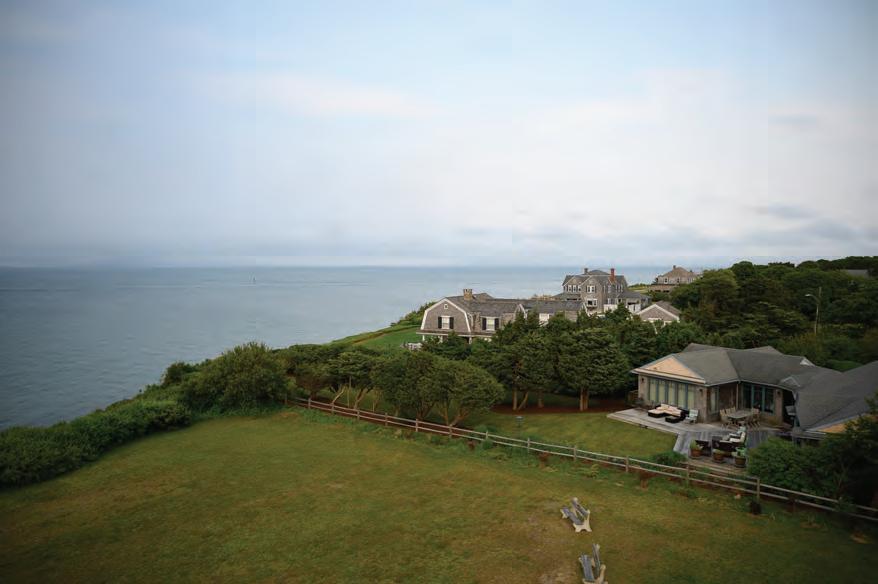
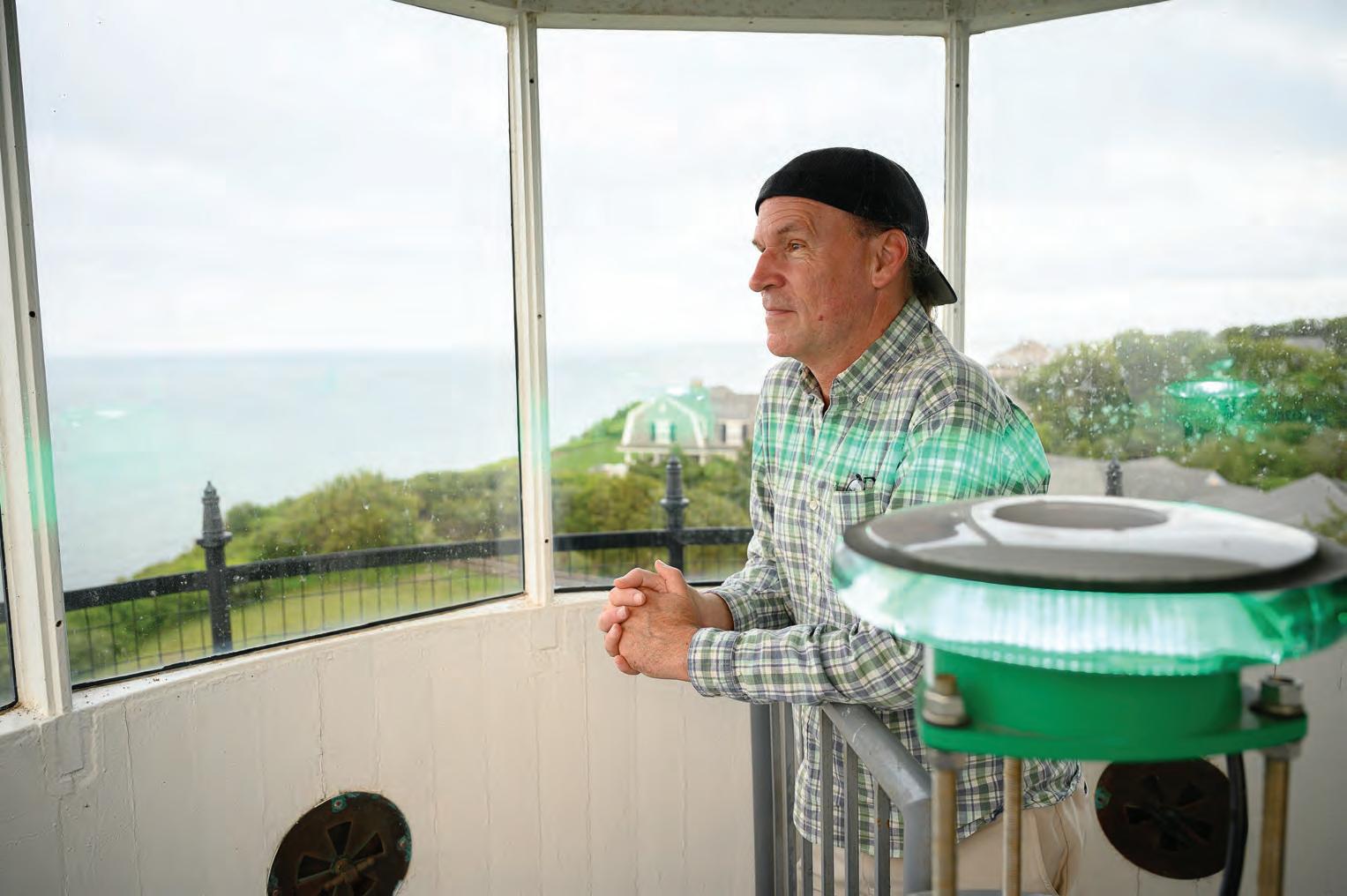


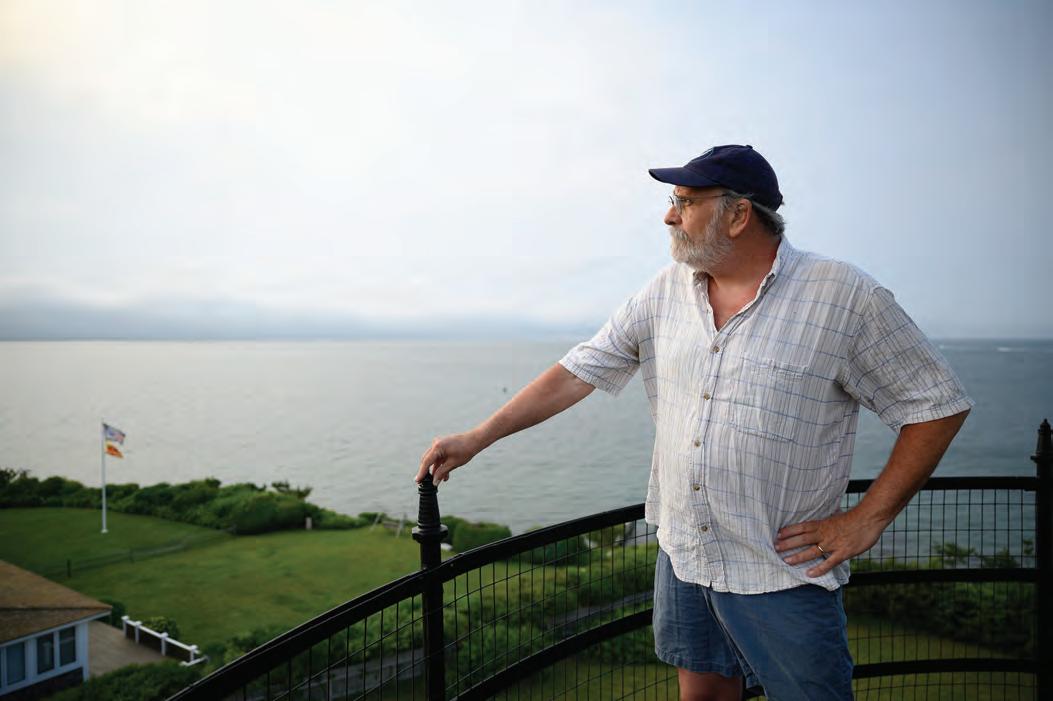
For Steve, who lives in a jewel-box Oak Bluffs cottage with his wife Liz Durkee and is recently retired from being the longtime art director of the Vineyard Gazette, the chance to pass on a bit of Vineyard history to others was irresistible. Also a former Vineyard summer kid and a yearround Island resident since 1990, Steve is a big guy with a soft heart — and the self-appointed child wrangler at the lighthouse.
“My job in the lantern room is to bang on the glass and tell people to be careful,” he says. He also confides that kids love to throw stuff off the balcony, run down and pick it up, and run back up to the top of the tower to do it all over again. After a round of that, Steve gently encourages a redirection of energy. After all, there can be anywhere from 30 to 100 visitors to the lighthouse on any given Sunday evening.
Another crucial duty is keeping visitors out of the lighthouse for a few minutes if a marriage proposal is about to happen. This happens a few times a year – as do weddings at the lighthouse, which can be reserved for special events.

“ The best thing is seeing visitors return year after year. There is a family that used to come every year with their little girls, always dressed in matching outfits,” Steve recalls. “Every year
coming back with their own children.”
And then there are the passionate lighthouse aficionados.
“ There are legions of them,” Steve says, “who regale us with their stories of other lighthouses when they visit.”
lighthouses all over the country.
On the Vineyard, if the season and the stars align, these enthusiasts will have an opportunity to visit three of the Island’s five lighthouses: East Chop Light and Edgartown Light, both Aquinnah. West Chop Light is not open to the public, and over-sand tours to Cape Pogue Light, managed by The Trustees of Reservations, are on hiatus.
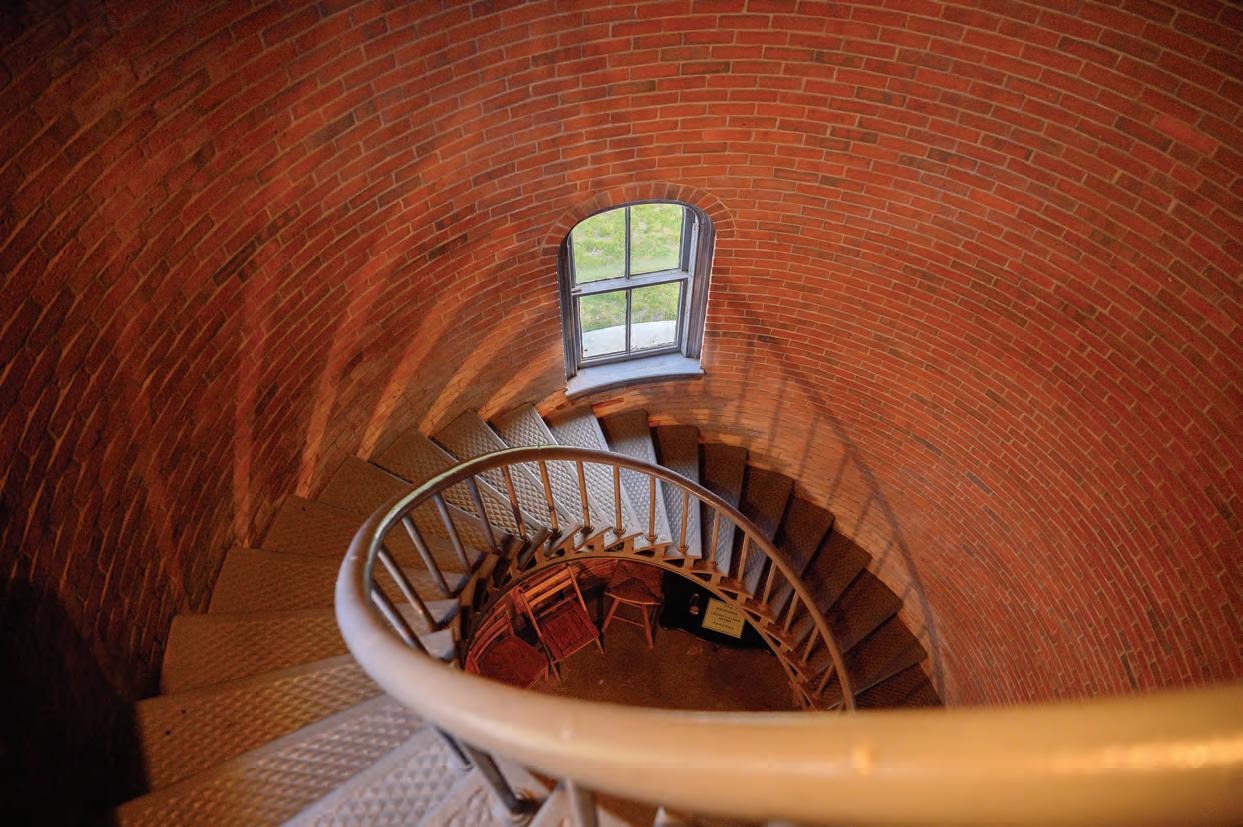
“People have a genuine interest in lighthouses,” Steve says. “I like being part of passing on the history, the knowledge, to other people.” Especially the history of the East Chop Light, because it’s part of the identity of the town Steve loves. “Just like the Gay Head Light is for Aquinnah, the East Chop Light is an icon for Oak Bluffs,” he says.
Sure, the lighthouse isn’t absolutely necessary in today’s high-tech world, Rob concedes. “But I know fishermen, sailors, boat captains who still use it, just like they still use their intuition. There’s very much an old-world reliance of looking up and seeing that light as a physical touchpoint. GPS can fail, but the lighthouse is always there.”
For Rob, satisfaction comes from knowing that he and Steve, with the museum’s stewardship, are helping to keep the doors open to a place that was closed to the public for most of a fiftyyear span. (Not to mention that they’re keeping the windows clean!)
“I love being part of something that has such a vital history, and I love being a part of getting people in there to experience it,” Rob says. “Though I’m not saving lives anymore, this is an entity that was.”
Susie Middleton is editor of The Vine
Of the five Vineyard lighthouses, East Chop Light was built last, after Gay Head Light (1799), Cape Pogue Light (1801), West Chop Light (1817) and Edgartown Light (1828).
The two spits of land (or “chops”) that flank the entrance to Vineyard Haven Harbor are, of course, called East Chop and West Chop. Though they were both natural spots for navigation aids — back when Vineyard Haven was called Holmes Hole and hundreds of schooners anchored regularly in the harbor — West Chop was awarded a light long before East Chop. The first West Chop Light was built in 1817 with $5,000 appropriated by Congress, while over on East Chop a telegraph semaphore station — but no light —was erected in 1828. Many mariners thought there should be a light on East Chop, too, to provide for the safest entrance into the harbor.
The government resisted for so long that in 1869 a private citizen, merchant marine captain Silas Daggett, took it upon himself to erect the first East Chop Light. Daggett’s structure burned in a fire in 1872, but he promptly rebuilt it. Though he had some financial help from other mariners, maintaining a lighthouse privately proved to be a difficult proposition.
Fortunately, the United States Lighthouse Board at long last “saw the light” on the necessity of a light on East Chop. In 1875, Congress authorized $5,000 for the light station, bought Daggett’s rather rustic structure from him in 1876 and promptly built a castiron lighthouse in its place in 1877.
The light had a fourth-order Fresnel lens made up of about 350 prisms, able to beam light a distance of 10 to 15 miles. In comparison, the Gay Head Light’s Fresnel lens that now resides in the Martha’s Vineyard Museum was a first-order light with 1,008 prisms that could project a beam 21 miles. (In the 19th century, Vineyard Sound was the 1-95 of waterways, with thousands of ships a day passing through it.)
In 1984, East Chop Light’s Fresnel lens was replaced by a modern beacon with a three-second green flash (three seconds on, three seconds off). It still beams light to mariners today.
The 40-foot-tall lighthouse was initially painted white, but sometime during the 1880s it was painted a chocolate brown, earning it the nickname of the chocolate lighthouse (1950s photo, lower right). In 1988, it was repainted white to prevent the inside of the lighthouse from overheating.
From 1912 to 1934, George Walter Purdy cared for the lighthouse, lived
on the property with his family and kept a cow across the street. Purdy had only one arm, having lost the other to an engine accident on a lightship. Yet he could build or fix anything, from a secure boat landing for the lighthouse tender to a sturdy flight of steps up from the beach (a 30-foot rise). He regularly painted the tower himself and cleaned the kerosene soot from the windows. He would be the last keeper to live on the grounds.
The light was automated (connected to electricity) in 1934. Not only did that eliminate the need to fuel the light with kerosene or oil; it also meant that a lightkeeper did not have to periodically wind a clockwork mechanism – a cable with heavy weights – to keep the light in rotation. When you visit the lighthouse today, you can see a hole in the floor of the workroom where the cable passed through on its way to the first floor.
After the Purdys, with the exception of a period during World War II when Islanders used the light to look for German U-boats, the tower was visited less and less. Funding for lighthouses shrank. The light fell into disrepair.
In 1985, with demolition threatening, an organization called the Vineyard Environmental Research Institute (VERI), led by William Waterway, set about lobbying Congress to acquire the license to run the lighthouse. With help from Congressman Gerry Studds and Senator Ted Kennedy, they were successful and became one of the first private entities to manage a lighthouse. They immediately embarked on raising funds for a much-needed restoration.
In 1994, the Martha’s Vineyard Historical Society (now the Martha’s Vineyard Museum) accepted the transfer of responsibility for East Chop Light from VERI, and today, while the United States Coast Guard owns the building (and the Coast Guard ANTS — Aids to Navigation Team — service the actual light), the museum maintains the tower and employs a part-time lighthouse keeper (Rob Hammett, see page 20). The land surrounding the lighthouse is an Oak Bluffs town park.
The light is open to the public at sunset on Sunday nights during the summer. (7 to 9 p.m. in June and July; 6 to 8 p.m. in August.) For more information, visit mvmuseum.org.








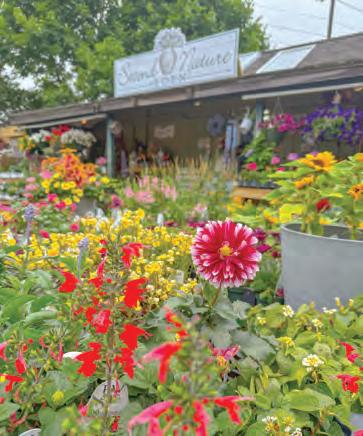







STORY AND PHOTOS BY MINDY DUTKA
It might not seem possible to enjoy the beaches and trails of Martha’s Vineyard anymore than you already do. But add a dog to the mix, and the Island comes alive in a whole new way.
Dogs don’t just walk the beaches, they frolic. They don’t just explore the trails, they revel in them, noses to the ground, tails high, hearts wide open.
Watching a dog experience nature on Martha’s Vineyard is like watching joy in motion. You start seeing the Island through their eyes. Every breeze carries a story, every wave is an invitation and every moment is the best one yet. Dogs don’t have any
trouble staying present!
For me, every time I see my dog’s joy ripple through her body, I think, “How lucky am I to be here, seeing it all through her eyes?”
No wonder so many of us bring our dogs along for a hike or to the beach — their happiness spills over and we realize what’s important. And summer (or fall!) on the Vineyard gets that much sweeter. Note: be sure to check online before you go. Some Island beaches and trails do not allow dogs in summer.
Mindy Dutka is a photographer, dog advocate and founder of dogsimeet.com.




BY SUSIE MIDDLETON • ILLUSTRATIONS BY CHRIS BURRELL

THAR SHE BLOWS! The Old Whaling Church in Edgartown was built in 1843 by master shipwrights. Records show that at least five whaling captains were members of the congregation who raised the funds to build the church. Records also list mariners, mariners’ wives, blacksmiths, carpenters and riggers — all of whom derived at least some income from the whaling industry –as congregation members.


CRAFTING CATS. In the building now known as The Old Sculpin Gallery in Edgartown, carpenter, cabinetmaker and boatbuilder Manuel Swartz Roberts opened a shop in 1905. Over the next 53 years, he would build 200 catboats, while also maintaining a reputation for being the man who could fix anything – including children’s toys. He was nicknamed the Old Sculpin.
THAT’S OLD. The Vincent House, built in 1672, was home to eight generations of one Island family, who actively farmed 20 acres surrounding it. The home was located on the shores of Edgartown Great Pond but moved to downtown Edgartown in 1977 for preservation. Today you can view the house on the Vineyard Preservation Trust’s historic Edgartown walking tour.

KEEP ROLLING. The offices – and the 50-year-old Goss Community press – of the 179-year-old Vineyard Gazette newspaper are located on Edgartown's South Water street in the Captain Benjamin Smith house, built in the 1760s. While printing a 16-page paper, the pressmen routinely go through two full rolls of paper, each of which is roughly eight miles long.






